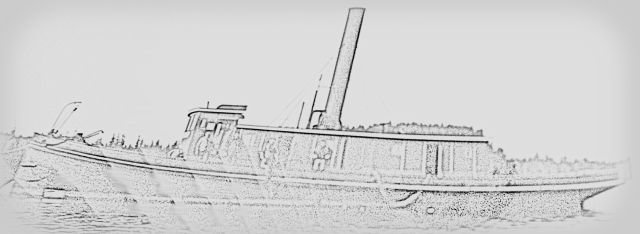Captain John M. Vanderbilt

SS Favorite, line drawing based on PCA-1-546, Vincent Soboleff Collection, Alaska State Library
Better scanned image hopefully coming soon to the ASL digital collection! In the meantime, consult the ASL hard copy photo collection.
----Draft Status: "Gamma"; nearing final completion---
Captain John M. Vanderbilt played a crucial role in the establishment of the Northwest Trading Company and was one of the early American settlers in Southeast Alaska following Seward's 1867 purchase.
Vanderbilt was born on Staten Island, New York, May 1, 1848, moving westward to Portland, Oregon, in 1872 at age 24. His initial employment in Oregon brought him into contact with Paul Schulze's burgeoning transportation operations, soon to become the Oregon Railway and Navigation Company, and part of the Northern Pacific Railroad. Vanderbilt's first trip to Alaska was as purser aboard a mail steamer in 1874. Eventually he settled in Wrangell, Alaska in 1878. In 1880, Schulze recalls Vanderbilt to Oregon to assist with organizing his Northwest Trading Company operations. Schulze must have spied some organizational talent in Vanderbilt, for he was soon to rely on him as the key figure in the NWT Alaskan operations.
1880 was a keystone year for Vanderbilt and the fledgling NWT. Captain J.W. Keene had outfitted the Favorite in Portland and brought her to Alaska to supply NWT operations. At some point during 1880, Vanderbilt assumes command of the Favorite. While the Favorite was in Sitka in the late fall of 1880, news of Richard Harris and Joe Juneau's gold strike arrived. Vanderbilt must have done some quick organizing, for in a matter of days, the Favorite set out for Juneau, already carrying supplies and George Pilz's knocked-down frame house (Juneau's first), in addition to the first wave of miners. In those first few days of December 1880, almost everyone present was swept up in the frenzy of staking gold mining claims, including the officers of an attending naval ship, the U.S.S. Jamestown. However, after discharging his cargo of eager miners, Captain Vanderbilt instead moved a short distance away from the gold strike to north Douglas Island, to stake three claims for homesteads, one for himself, and one each for the U.S. collector of customs and his deputy at Sitka. These actions speak to Vanderbilt having more of a keen eye for business relationships than for the speculative action on the gold fields, as an astute businessman knows that the real money in a gold rush is to be made in other ways than finding the nuggets. At this point in his life, Vanderbilt is also looking out for his young family. Deep snow was to put a damper on further claim staking that winter, but by March of 1881, Capt. Vanderbilt re-appeared in Juneau with the Favorite, towing a barge to be used as a mobile mercantile, Juneau's first store, already stocked and ready for business. (DeArmond 1967, 1990)
By early November of 1881, Vanderbilt has left the scurrying voyages of the Favorite and is settled in Sitka "enjoying life with my family" where he notes "being on shore does not mean a release from business cares for we have here a large store and other matters to look out for...." (Vanderbilt 1881). Vanderbilt also mentions in that letter that the NWT was "...engaged in photographing this section of Alaska for the purposes of enlightening the ignorant people of the outside...". Those photographs have not been located, except for perhaps two photograph PCA-1-235a and PCA-1-236b in the Vincent Soboleff collection at the Alaska State Library. (note the photographer could possibly be Henry H. Brodeck, of Walla Walla Washington, who Mautz 1997 lists as " views marked Photographed for the Northwest Trading Co.", and "active in Alaska and California in 1881". Brodeck would have had contact with Schulze's operations during his time in Walla Walla and earlier in Portland.)
At some point during 1882, Vanderbilt has moved back to Killisnoo, for he is clearly managing the company operations there at the time of the infamous Angoon bombardment incident of October 1882. Vanderbilt's letter of March 1885 (Vanderbilt 1885a) still located him in Killisnoo, but lamenting the departure of his wife and children who have moved back to New York, apparently in need of more creature comforts than could be obtained at the remote Killisnoo location. In that March 1885 letter, a forlorn Vanderbilt is seeking employment back east to be reunited with his family, and with the Northwest Trading Company under financial hard times. By Vanderbilt's letter of October 1885 (Vanderbilt 1885b) things are improving; his family has returned to Killisnoo (although he laments removing the children from school), prices for NWT products are improving, and production is expected to double the following year. However, within a year the Northwest Trading Company has failed, and Vanderbilt moves to Sitka, purchasing the former NWT store there with his friend De Groff. He remains in Sitka till his death in 1890 at age 42.
Back to: History of Southeast Alaska Herring Fisheries
Link to: References
Caution: These pages contain preliminary research results, and are presented here only to further collaborative research and analysis. The information presented has not been fully analyzed or verified for correctness. Please consult the original literature citations for authentic interpretations or contact the author regarding applications of any analysis presented on these pages.
For more information, contact Fritz Funk:
fritz funk.io
| Last modified: Apr 12, 2008 at 21:14:42
funk.io
| Last modified: Apr 12, 2008 at 21:14:42

